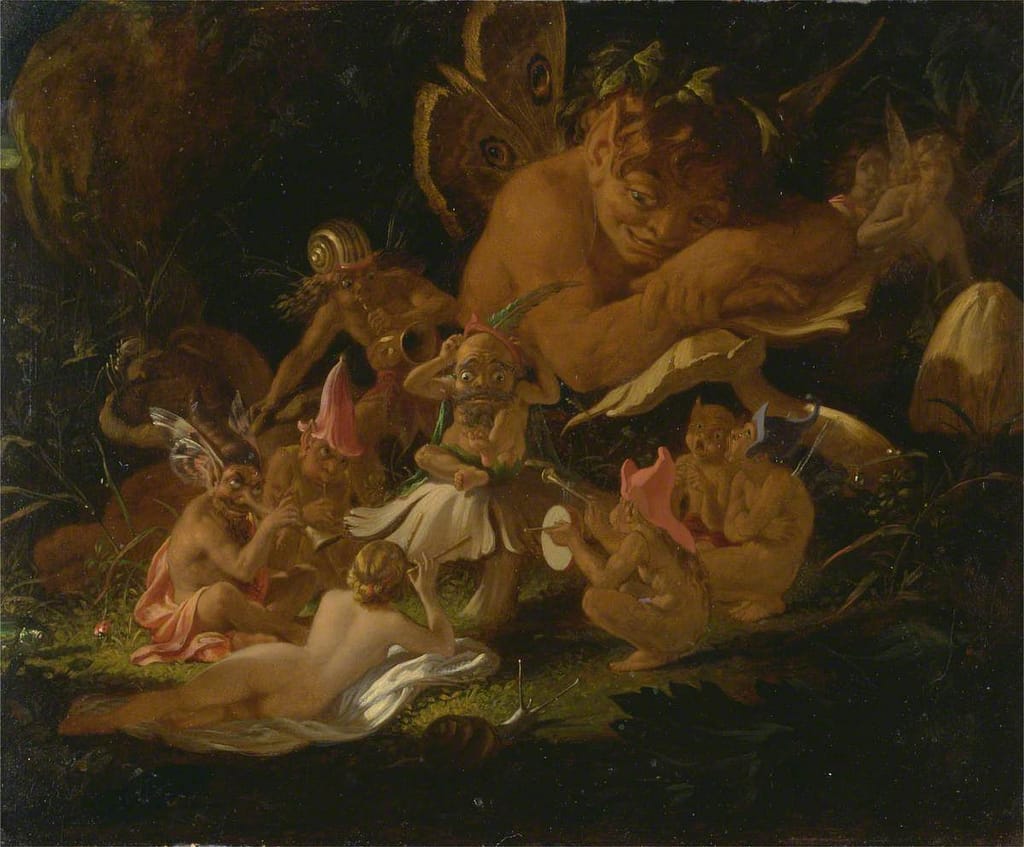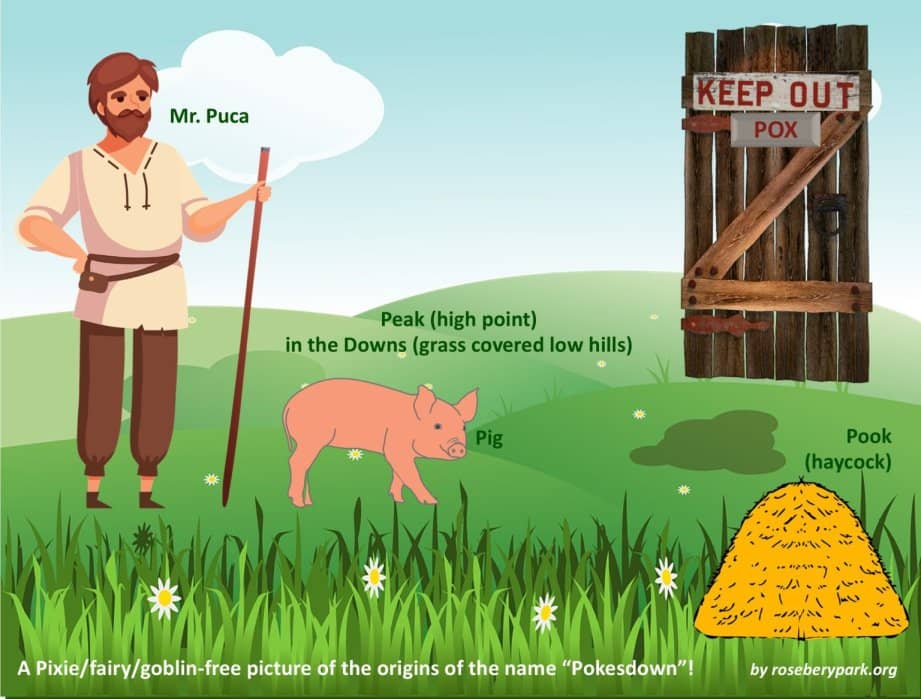I have seen no written evidence for this, but anecdotally it is also suggested that some Christians dislike the name “Pokesdown” because of its unsubstantiated but popular association with pixies/fairies/witches/
goblins. To many non-Christians, pixies and fairies sound like mischievous, harmless, fun. But a Christian’s internal alarm bell may ring at the mention of a supernatural entity (even if it’s a made-up one) that is not from God.
Witches and goblins are even more disturbing. The Merriam-Webster dictionary defines a “goblin” as “an ugly or grotesque sprite that is usually mischievous and sometimes evil and malicious”.140 You can see why a Christian might be reluctant to name their church or area the church is in after a name which some translate as “Goblin’s Hill” – “Welcome to the ‘Hill of the Evil & Malicious Supernatural Creature’ Baptist Church”!!
The fact that the reference book for “Kit with The Candlestick” and “Puck” and “Pooka” is called “The Complete Book of Devils and Demons” should also go some way to help explaining the Christian’s disquiet about this being the origin of the name “Pokesdown”!134f

Yale Center for British Art. Source: Art UK.
There is some of evidence of local religiously-motivated strong views: we know that in Boscombe, in 1896, a local person added an architectural “grotesque” to his roof top to stare in protest at the theatre opposite in disapproval of it daring to open on Sundays.141And there was opposition to trams running on Sundays too.142
But as there is no written record of Christians rejecting the name of Pokesdown on religious or spiritual grounds at any point in its history, we can only speculate.
If we zoom out from Pokesdown, and look at the whole of England, it’s still difficult to get a picture of the strength of Christian opinion on the subject of pixies/fairies/witches/ goblins, because there is room for different opinions within Christianity, and because of big shifts in opinions during different periods of history. To give two examples, there is written evidence of late-Elizabethan and seventeenth-century English Protestants equating fairies with ‘falsehood, Catholicism, and the invisible wiles of the Devil’.143 But there was also Reginald Scot’s publication in 1584, called ‘A Discovery of Witchcraft’, which, The British Library explains, was:
“a sceptical treatise recording and debunking popular and scholarly beliefs about witchcraft, magic and other superstitions. Scot argued that belief in magic was both irrational and un-Christian. He suggested non-magical reasons and causes for both magical phenomena and accusations of witchcraft. These included psychological and sociological causes.” 143aa
A 1921 journalist telling us about Reginald Scot describes his comprehensive work as aiming to prove
“that the belief in witchcraft and magic was alike opposed to reason and religion… he did his utmost to stay the cruel persecution habitually pursuing poor, aged and simple persons popularly credited with being witches… his work for a time made great impressions on the magistracy and clergy…”
But when James I became king he ordered all of Scot’s works burned. In 1684, Scot wrote:143a
“In our childhood our mother’s maids… so frayed us with hill-beggars, spirits, witches, urchins, elves, hags, fairies, satyrs, Pans, fauns, sylvans, Kit-with-the-Candlestick, [nineteen other named creatures], Hobgoblin, and such other bugbears that we are afraid of our own shadows…”
“Well, thanks be to God, this wretched and cowardly infidelity since the preaching of the Gospel [the good news that Jesus saves us from our sins and reunites us with a loving and forgiving God] is in part forgotten, and doubtless the rest of these illusions will in a short time, by God’s Grace, be detacted and vanish away.”
The 1921 journalist telling us about Scot adds:
“Alas! For the doughty Reginald, his hope of the passing of such illusions in a short time was many, many long years from realisation… it was that statute of James I that was responsible for the long-continued belief in witchcraft.”
I admire Reginald Scot’s attitude – we are not fearful of pixies and goblins because we believe they are real; instead the reason we dislike them so much is because they are the antithesis of Jesus’ way [we should love other people, NOT try to trick them, and trip them up!], and the IDEA of their existence causes fear, and was used to persecute people who didn’t fit the mould of mainstream society. Getting to know Jesus would both wash away these superstitious fears, and remove the scape-goating of the vulnerable.
Then, if we skip forward in time, English theatre historian, Michael Booth, states:
“The acceptance and rapid growth of fairyland as a fit subject matter for literature, painting, and the stage from the 1820s to the 1840s and its survival until at least the First World War is one of the most remarkable phenomena of 19th-century culture.” 144
Fairies and pixies were now accepted and admired! So much so, that one of Queen Victoria’s Royal yachts was called “Fairy”144a, and Prime Minister, Disraeli, wrote and thanked the Queen for her “Faery gift”, in the manner of Queen Titania, of snowdrops.144b

with a Pig, looking at a Pook (haycock) and staying away from the Pox! 144d
If “Poke-” potentially coming from pixies is an issue for some Christians, hopefully they can take comfort from the fact that, even if some people choose to associate the name with supernatural folklore, there is no conclusive proof that the origins of the name “Pokesdown” stem from pixies/fairies/witches/goblins. It’s just as likely to have come from someone’s surname, or the local dialect for “haycock”, or stem from “peak’s down” where “peak” means “high point” in the downs, or possibly from when pigs used to be kept on the downs, or maybe from a period when Pokesdown was used as a holding area for people with the pox. And if the name DID come from pixies, the pixies in question may have been, as archaeologist Calkin suggests, a “folk memory” of Pokesdown’s earliest Bronze Age inhabitants. Or a gassy, chemical, glow-in-the-dark134b, and not a (made-up) supernatural being out to cause trouble.
“…there is no evidence that [Puck] visited the top of Pokesdown Hill…” ~ Bournemouth Guardian, Saturday 20 October 1906.144c
The copy and paste citation for this page:
The History of Rosebery Park Baptist Church and Pokesdown – Pokesdown: the name, Page 6. Author: Michelle Fogg. Date: May 2022. Url: https://roseberypark.org/history/pokesdown-the-name-6/
Sources of Information for The History of Rosebery Park and Pokesdown (opens in new tab)
Go To About Us
Go to Other Activities
Rosebery Park Baptist Church, 812-814 Christchurch Road, between Boscombe and Pokesdown, Bournemouth, BH7 6DF
